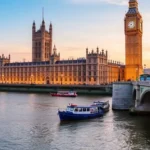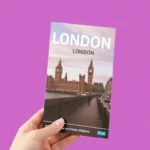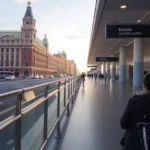Tips for Traveling to London Independently
- 1. Required documentation for traveling to London
- 2. Getting to London from the airports
- 3. Navigating London
- 4. The best time to travel to London
- 5. Top attractions in London
- 6. How many days are needed to see London?
- 7. Avoid withdrawing money at the airport: a key tip for traveling to London
- 8. Food options in London
- 9. Finding accommodation in London
- 10. Check the opening dates of London markets
- 11. Get ready for your trip to London with a book or movie
- 12. Useful apps for traveling to London
Are you looking for tips for traveling to London on your own? In this article, we’ll provide you with valuable recommendations for visiting the capital of England while avoiding common pitfalls in your planning. Essentially, we will share everything we wish we had known before stepping foot in the English capital. From the best time to visit London to the must-see attractions, transportation tips, accommodation options, and much more!
This article is crafted with first-time travelers in mind who might feel lost in the vastness of this vibrant city. If you find yourself in that situation, rest assured that it’s entirely normal: London is a sprawling metropolis teeming with activities, decisions to make, and plans to organize. Trust us, you’re in good hands.
London has been, is, and will always be in vogue. At first glance, it may appear to be a gray city, often associated with dreary weather and a certain aloofness, yet there’s something about it that draws in every visitor. It’s not exactly love at first sight; rather, it’s one of those places that wins you over gradually until it holds your heart completely.
Have you booked your flight but don’t know where to begin organizing your London trip? Don’t panic; we’re here to provide you with all the keys to traveling in London (and avoiding major blunders), from how to navigate the city to where to find accommodation.
So without further ado, let’s dive into the tips for traveling to London:
1. Required documentation for traveling to London
Post-Brexit, traveling to London and other areas of the United Kingdom requires more than just an ID card, as was the case previously. Now, all travelers, including Europeans, must carry a valid passport and also apply for an ETA (Electronic Travel Authorization) online in advance at the official website. The fee for this is £16.
If you're from outside Europe, you won't need to apply for a visa; the ETA is the only essential requirement. However, it's advisable to check the UK immigration website for the most accurate and updated information.
Regarding free roaming, this has also been eliminated throughout the UK, although some telecommunications companies have implemented special rates for travelers to these countries. For more information on how to access the internet in the UK and what SIM and eSIM cards to purchase, check the link.
2. Getting to London from the airports
London connects with the world through six major airports: Heathrow, Gatwick, Luton, Stansted, London City, and Southend. Many low-cost airlines operate flights to these airports, and you’ve probably booked your ticket with one of them. But do you know how to get from the airport to central London?
→ Here’s a guide on how to reach central London from each airport.
One of the best tips for traveling to London is to familiarize yourself with how the transportation system works in the city!
The transportation network in London is among the most efficient in the world, comprising various modes: tube, bus, train, DLR (Docklands Light Railway), and riverboat. The best way to explore central London is on foot, but if you need to use transport, the underground or the iconic double-decker buses are your best bets.
Here are some transportation tips for London:
What you need to know
- Zones: London is divided into 9 zones, with zones 1 and 2 housing most of the city's attractions and accommodations.
- Fare differences: There are two fare pricing structures based on the time of day: the Peak rate, which is higher, applies on weekdays from 6:30 AM to 9:30 AM and 4:00 PM to 7:00 PM; the Off-Peak rate applies at all other times. This differentiation does not apply to buses and trams.
- Single tickets vs. passes: It is always more cost-effective to use passes and cards rather than purchasing individual tickets. The go-to transportation card is the Oyster card, but there are also Travelcards available for one or seven days, as well as daily bus and tram passes.
- Daily cap: One of the biggest advantages of using the Oyster card is the daily spending limit, regardless of how many times you use the transport system. This cap is determined by the type of transport you use. Note that the day counts from 4:30 AM, so you'll remain within that limit until 4:29 AM the following day.
- Child fares: There are special fares for children under 16 on all forms of transport.
- Online help: To plan your journey, locate your hotel, and find the most important attractions, you can check the official website of Transport for London.
Are travel passes and tourist cards worth it?
It’s clear that one of the best tips for traveling in London is to get a transport pass, as individual tickets can be quite pricey. But which one should you choose? It all depends on how long you plan to stay. Let’s look at some scenarios:
Regarding tourist cards, take a look at the London Pass and the London Explorer Pass. First, do some calculations to see if they are worth it. Generally, they are only advisable if you plan to visit numerous attractions, and the total cost of the entry fees accumulates significantly. (Keep in mind that some of the most important sites in the city are not included).
Additionally, you can combine them with an Oyster Travelcard, which is valid for the same period. However, in our opinion, these tourist cards rarely compare favorably with the daily cap of a standard Oyster card.
Are they worth it or not?
Let’s examine some examples with typical itineraries:
- For 1 to 5 days with a preference for free attractions: the best option is to buy the Oyster Card.
- For 1 to 5 days with plans to visit all possible attractions: Oyster Card + 3-Day London Pass. Use the three days of the London Pass to visit paid sites and the other two for free attractions.
- For 6 to 7 days with a preference for free attractions: a good idea would be the 7-Day Travelcard.
- For 6 to 7 days, visiting all attractions: 7-Day Travelcard + 3-Day London Pass. Use the three days of the London Pass for paid sites and the rest for free attractions.
4. The best time to travel to London
When is the best time to visit London? The answer is a bit complicated… It is well known that London experiences a fair amount of rain. However, we believe that any time of year is good for a trip to the English capital.
Personally, we think that the spring and autumn months are the best. The temperatures are moderate, leaning toward cool, and although there are always tourists in London, it’s less crowded than in summer, and it’s not as cold as in winter.
Don’t forget to get IATI travel insurance with a 5% discount here for any destination you choose!
5. Top attractions in London
While there are plenty of things to see in London, here’s our top 5:
- Big Ben and the Houses of Parliament: This gothic Victorian complex is not just the epicenter of British politics but also home to Big Ben, the famous clock bell in Elizabeth Tower. So every time you hear its iconic “bong,” you know you’re in the heart of the UK!
- London Eye: Ever wanted to fly over London like Peter Pan? Well, the London Eye is the closest you’ll get (at least without magic). This giant 135-meter-high Ferris wheel offers breathtaking panoramic views. Be sure to buy your London Eye tickets in advance to skip the lines.
- Tower of London: This historical fortress has served as a royal palace, prison, and treasury (among other things). Today, it’s famous for housing the Crown Jewels. A tip: nearby is Tower Bridge, which you shouldn’t miss.
- The British Museum: If you’re a history and culture lover, this is your paradise. The British Museum holds a vast collection of art and antiquities from around the world, including the mythical Rosetta Stone and some sculptures from the Parthenon.
- Shoreditch: This neighborhood is famous for its artistic and alternative atmosphere, filled with street art, galleries, markets, and vintage shops.
Additionally, here are three tours and activities we recommend booking in advance:
Tip: don’t forget to book the free tours in London that interest you since they tend to fill up quickly! Remember that while there’s no fixed price, it’s customary to give a tip at the end to the guide.
6. How many days are needed to see London?
Whenever we’re asked how long it takes to explore London, we answer that this city cannot be fully explored in a lifetime, but with 3 days, you can make the most of your visit!
→ Check out our 3-day itinerary for London.
If you only have one day in the city, whether because you’re passing through on a layover or you found a great deal for 24 hours, a good idea is to maximize your time by joining a comprehensive tour of London, taking you to the most iconic locations.
If you have several days, it’s ideal to take advantage of some of the best excursions from London. Renting a car for three days and touring the Cotswolds sounds like a fantastic plan.
7. Avoid withdrawing money at the airport: a key tip for traveling to London
Resist the temptation to exchange euros for pounds at the airport. If you need to exchange money, it’s advisable to do so at a currency exchange in the city center, where they are usually concentrated in stations and tourist areas. However, don’t settle for the first one you find; compare rates before deciding, and be sure to visit several. Banks also typically don’t offer the best deals.
Our recommendation, however, is to use a card for all possible payments, withdraw cash from ATMs, and only exchange a small amount at the airport (a safety net for initial expenses).
Cards for traveling without fees
We’re not fans of carrying large amounts of cash, especially in destinations where the currency isn’t euros. But be cautious of fees! Here are some solutions to access money abroad without fees.
Currently, we primarily use the Revolut card, which is one of the most reliable cards (they even have a promo of €10 for new users!). We also recommend the N26 card. Both have free versions and offer excellent conditions to save on fees, but with certain limitations, making them an ideal complement. We recommend carrying both, along with your regular bank card in case one fails.
8. Food options in London
In London, you’ll find many more options than you might think for enjoying delicious meals without breaking the bank. Here are a few restaurants where you can eat well for cheap, and here are our top 10 food trucks in London.
A helpful tip for your trip is to reserve judgment on the food before trying it. While it’s true that English cuisine doesn’t have the best reputation, we found plenty of tasty options! If you want a sneak peek, check out the typical dishes to sample in England.
9. Finding accommodation in London
The good news is that there are increasingly more quality accommodation options available in the English capital. A few years ago, it was easy to end up in a shabby place, but the quality has improved significantly. You can find double rooms in well-located places with good reviews for around €100 per night (of course, there are cheaper options if you’re open to hostels).
→ This post provides several ideas on where to stay in London (best areas and hotels).
One of the best tips for traveling to London is to look for central accommodation: as you’ve seen, transportation isn’t particularly cheap, so staying far away means investing more in transit (and also wasting precious time).
The downside is that prices have risen significantly since the pandemic, so our best advice is to book accommodation months in advance (with a free cancellation option, just in case).
10. Check the opening dates of London markets
Camden, Portobello, Brick Lane, Borough Market… London offers countless options to immerse yourself in street life (and make a few purchases). The city boasts dozens of markets, and while most peak on Sundays, you can find many alternatives throughout the week.
Check which markets are open during your travel dates:
- Camden: open daily from 10:00 AM to 6:00 PM.
- Portobello: open daily from 8:00 AM to 7:00 PM, closes at 5:00 PM on Sundays.
- Borough: closed on Mondays.
- Brick Lane: open on Sundays from 10:00 AM to 6:00 PM.
Tip: Make sure to check the hours before heading out to the markets. We do our best to keep the information updated, but we might miss something! You can easily verify it on Google.
→ Here’s a guide to the best markets in London, featuring information on shopping, markets, and places to go shopping in London.
11. Get ready for your trip to London with a book or movie
If you want to start experiencing your trip from the comfort of your home, here are some movies and books to help you get immersed in London, both present and past:
Movies
- Love Actually,
- Notting Hill,
- Match Point,
- The Diary of Bridget Jones,
- The King’s Speech,
- Harry Potter,
- Sweeney Todd,
- The Da Vinci Code,
- Sherlock Holmes.
Books
- London Stories (Enric Gonzalez),
- Oliver Twist (Charles Dickens),
- This is London (Milan Sasek),
- The Picture of Dorian Gray (Oscar Wilde),
- London (Virginia Woolf),
- A Tale of Two Cities (Charles Dickens),
- The Great Mystery of Bow (Israel Zangwill),
- London (Edward Rutherfurd),
- Meanwhile in London (Rebeca Rus).
12. Useful apps for traveling to London
Another tip for traveling to London and avoiding major mistakes is to download some useful apps. Here are a few applications that will assist you during your visit:
- CityMapper: This popular app helps you navigate the city using public transport. Simply input a starting point and a destination, and it’ll provide you with all possible routes.
- City Maps 2Go / Mtrip / Maps.me: These apps are fantastic for creating personalized maps and using them offline.
- Street Art London: One of our favorites, it helps you locate nearby street art (or anywhere else) and filter by artist, etc.
- OpenTable: This app lists numerous restaurants in London, complete with reviews, prices, maps, and ratings. The Fork is also a great option.
- Uber, Bolt, or My Taxi: Perfect for occasional transportation in London.
We also have a few recommendations for your trip to London:
- The weather in London is unpredictable, so bring layered clothing so you can shift your look from "tropical summer" to "Arctic winter" in the blink of an eye. Don’t forget to pack a raincoat or an umbrella.
- Of course, wear the most comfortable shoes you own: you will walk a lot in London, and it’s best to be as comfortable as possible.
- Remember that cars drive on the left side of the road, so be cautious when crossing streets.
- While London is generally a safe city, it’s always wise to stay alert, especially in touristy or crowded areas, like the subway. Unfortunately, pickpockets exist, as they do in all major cities.
- Traveling on a backpacker’s budget? Great! London offers a ton of free activities; in fact, most of the museums in London are entirely free.
- Do you love fun facts? Then check out our post on curiosities about London to learn more about the city.
| Save on your trip |
| Compare and find cheap flights here |
| Find accommodation at the best prices here |
| Book activities and excursions in Spanish here |
| Get IATI travel insurance with a 5% discount here |
| Reserve transfers from the airport here |
| Get a €10 gift for booking transportation in Europe here |
| Learn how to withdraw money without fees here |
| Buy a SIM card with discount for traveling with internet here |
| Rent a car with the best offers here |
| Compare prices for van rentals here |
| The best books and travel guides here |
| All our articles about London |
* Photos from Shutterstock





Deja una respuesta